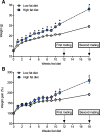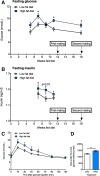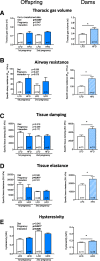Maternal high fat diet compromises survival and modulates lung development of offspring, and impairs lung function of dams (female mice)
- PMID: 30700289
- PMCID: PMC6354360
- DOI: 10.1186/s12931-019-0976-3
Maternal high fat diet compromises survival and modulates lung development of offspring, and impairs lung function of dams (female mice)
Erratum in
-
Correction to: Maternal high fat diet compromises survival and modulates lung development of offspring, and impairs lung function of dams (female mice).Respir Res. 2021 Mar 14;22(1):81. doi: 10.1186/s12931-021-01681-4. Respir Res. 2021. PMID: 33715622 Free PMC article. No abstract available.
Abstract
Background: Epidemiological studies have identified strong relationships between maternal obesity and offspring respiratory dysfunction; however, the causal direction is not known. We tested whether maternal obesity alters respiratory function of offspring in early life.
Methods: Female C57Bl/6 J mice were fed a high or low fat diet prior to and during two rounds of mating and resulting pregnancies with offspring lung function assessed at 2 weeks of age. The lung function of dams was measured at 33 weeks of age.
Results: A high fat diet caused significant weight gain prior to conception with dams exhibiting elevated fasting glucose, and glucose intolerance. The number of surviving litters was significantly less for dams fed a high fat diet, and surviving offspring weighed more, were longer and had larger lung volumes than those born to dams fed a low fat diet. The larger lung volumes significantly correlated in a linear fashion with body length. Pups born from the second pregnancy had reduced tissue elastance compared to pups born from the first pregnancy, regardless of the dam's diet. As there was reduced offspring survival born to dams fed a high fat diet, the statistical power of lung function measures of offspring was limited. There were signs of increased inflammation in the bronchoalveolar lavage fluid of dams (but not offspring) fed a high fat diet, with more tumour necrosis factor-α, interleukin(IL)-5, IL-33 and leptin detected. Dams that were fed a high fat diet and became pregnant twice had reduced fasting glucose immediately prior to the second mating, and lower levels of IL-33 and leptin in bronchoalveolar lavage fluid.
Conclusions: While maternal high fat diet compromised litter survival, it also promoted somatic and lung growth (increased lung volume) in the offspring. Further studies are required to examine downstream effects of this enhanced lung volume on respiratory function in disease settings.
Keywords: Immune training; Inflammation; Lung development; Lung function; Maternal obesity.
Conflict of interest statement
Ethics approval
Experiments were performed according to the ethical guidelines of the National Health and Medical Research Council of Australia and with approval from the Telethon Kids Institute Animal Ethics Committee (AEC#280).
Competing interests
The authors declare that they have no competing interests.
Publisher’s Note
Springer Nature remains neutral with regard to jurisdictional claims in published maps and institutional affiliations.
Figures







References
-
- Western Australian Obesity Think Tank: Background paper: Curtin Centre for Behavioural Research in Cancer Control. 2007.
-
- Rusconi F, Popovic M. Maternal obesity and childhood wheezing and asthma. Paediatr Respir Rev. 2017;22:66–71. - PubMed
-
- Harpsoe MC, Basit S, Bager P, Wohlfahrt J, Benn CS, Nohr EA, Linneberg A, Jess T. Maternal obesity, gestational weight gain, and risk of asthma and atopic disease in offspring: a study within the Danish National Birth Cohort. J Allergy Clin Immunol. 2013;131:1033–1040. doi: 10.1016/j.jaci.2012.09.008. - DOI - PubMed
MeSH terms
LinkOut - more resources
Full Text Sources
Medical
Research Materials

